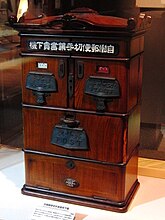Self service kiosks and self service in general was started to improve time & cost efficiency
Here is a brief slideshow outlining the birth of self service with the vending machine in the 1800’s and how it evolved over the years. We have come a long way since this technology first made the scene!
Letting customers do things themselves is more efficient, and gives them the control to get things done on their own terms. Whether the self-service be directions, information, check-in services, registration, or a purchase transaction, people just tend to prefer self-service options.Letting customers do things themselves is more efficient, and gives them the control to get things done on their own terms. Whether the self-service be directions, information, check-in services, registration, or a purchase transaction, people just tend to prefer self-service options.
We know that self service kiosks exist, but where did the idea of self-service even come from?
Self-service was first introduced in the 1880’s with the invention of the “vending machine”. At this point, it was a small stand or contraption that offered small products like postcards, gum, and stamps. A customer could take a product after placing money into the kiosk. This was the first time a customer was able to purchase a product without the help of a vendor. The first catalogs were introduced in the 1800’s. Catalogs gave customers the time to look over products and options to make a calculated purchasing decision.
In 1947, gas pumps became self-service for the first time…
This allowed people to pump their own gas. This decreased the time it took to get gas and saved customers money. New Jersey and Oregon are the only two states that do not have self-serve gas stations.
The 60s sparked the “call center” that later birthed the idea of IVR. The first ATM was open for business on September 2, 1969. (IVR) Interactive voice response was developed in the mid-70s as the first automated support. In 1992, Price Chopper released the first self-checkout kiosk, which, as we know from the past have been a little frustrating.
They’ve improved monumentally since the 90’s, as most technology has.
In the mid to late 90’s, online shopping started through Amazon and Ebay.
This essentially sparked the internet revolution of online shopping with as much as 70% of Americans now shopping regularly online. As the need for self-service increases, the need for more innovative technology does too. The first interactive kiosk, as we know them today, was developed in 1977 by Murray Lappe. He was a pre-med student at the University of Illinois at Urbana-Champaign. He called it “The Plato Hotline”, and it was used for informational purposes at the university. The first public kiosk initiative was developed in 2007. This provided public access to a new form of self-service technology. Self-service is a forever expanding concept that can create solutions that save time, cost, and energy for the consumer, employee, and employer.
Most importantly, it serves the people by letting the people serve themselves










